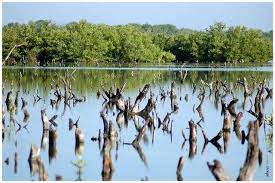Lic. Claudia Hernández Hernández
Implemented through the IRIS Climate Foundation and the GEF Small Donations Program, with the technical advice of the Coastal Ecosystem Research Center, CIEC, the Project Strengthening the coastal resilience of the Manatí community, of the Turiguanó Popular Council, north of Avignon municipality of Morón, with an adaptation approach based on ecosystems, promotes actions through natural solutions aimed at providing services that increase resilience and reduce the vulnerability of the ecosystem and the community to the impacts of Climate Change.
This was stated in the initial workshop, which brought together all interested parties with the intention of exchanging ideas, sharing experiences, creating synergies and setting the main guidelines to materialize the planned activities.
As explained by MS.c Evelyn Marichal Arbona, CIEC researcher, the intervention area covers 225.23 hectares and the Manatí community, made up of 107 residents, is located there: the main beneficiaries of the project.
Likewise, she points out, the area is located within Ramsar site number 1235 “Great Wetland of the North of Ciego de Ávila”, the second largest of its type in Cuba; which also has IBAS category (Code CU012) for being an important habitat for birds.
However, environmental and social problems converge in the area that impact the environment and the residents of the area. Changes in land use, saline soils, clogged lagoons, exotic species, selective logging of native plants, fishing and poaching; added to limitations with the supply of drinking water, few sources of sustenance in the community, poor housing conditions, insufficient infrastructure and services (education, transportation, health, telephone) as well as a marked aging of the population and the exodus to other settlements. , were the main motivations to give wings to a project that not only focuses on the community conservation of ecosystems, but also provides direct benefits to its residents, with emphasis on women, children and adolescents.
Given the complex situation described above, it is intended to implement sustainable initiatives that promote socioeconomic development and promote adaptation to the effects of climate change, with the support of various actors and participating bodies, such as the Turiguanó Popular Council, the Cooperativa de Credit and Services “Celia Sánchez Manduley” and the Turiguanó Genetic Livestock Company, in addition to the coordinating entities and the community.
Among the proposals, the assisted natural regeneration of 80 hectares of mangrove and 50 hectares of swamp forest stands out, for which a forest nursery will be created with a composting system as a source of organic matter. 20 hectares occupied by exotic species will be recovered, the resulting biomass of which will be used in the production of charcoal.
Rainwater collection systems will be located to improve the quality of life of the population and contribute to saving such a precious resource. 3 electric tricycles will be acquired for the transportation of equipment, positions and personnel. And parallel to all this transformation, the capacities of its inhabitants will be strengthened through an integrated system of actions, activities and communication.
In this sense, the President of the Popular Council, Silvia González García, highlighted the commitment that she feels with the project and highlighted the willingness of the community members to support the planned tasks.
This was also reported by Roberto Rondón Reyes, one of the community leaders, who pointed out that the initiative, by focusing on recovering the ecosystems, contributes to raising awareness on the part of the residents of Manatí about the problems that are being faced. facing climate change, offers tools to improve the lives of residents and contributes to society and the economy”
On the other hand, the executing entities recognize that they are far from being able to solve all the community’s problems; But committed actions offer benefits, both in the social and environmental spheres, that help meet basic needs that were until then limited.
However, this is only the beginning of future collaborative projects that integrate sustainable management, conservation and rehabilitation of ecosystems to continue supporting a Resilient Manatee.

